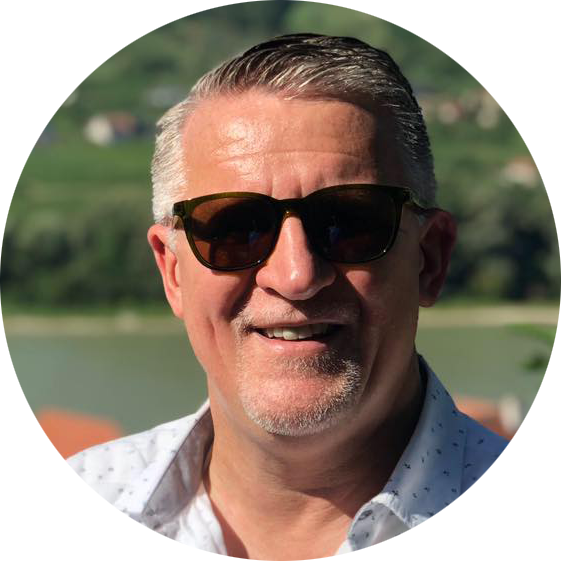Gay cruise fan shares his favorite Mediterranean ports
As veterans of numerous Mediterranean cruises , my boyfriend and I find ourselves returning to a few favourite ports. Here’s a canter through a few of the most popular Mediterranean ports, and some of our favorite attractions, in each city, with a special focus on their LGBT side.
Travel writer and cruise fan Marcus
Nice and the French Riviera
Nice and the wider French Riviera area exude charm, indulgence and desire. We’ve visited time and time again to enjoy the beauty, glamor and romanticism this port offers. After Paris, Nice offers perhaps the most LGBT-friendly vibe of any city in France.
If arriving by sea there are numerous ports that you can travel to including Nice itself, Cannes and Villefranche-Sur-Mer. Handily. they all connect via rail and other transport making it easy to get about and see the region, including Monaco which lies just next door.
When visiting Nice, there is nothing better to do than explore and experience the Promenade des Anglais, the 5-mile stretch of promenade along the Bay of Angels. Each time I’ve been I’ve seen totally new things and experiences. If you want to experience the grandiose history of Nice up to the mid-20th Century head to Vieux Nice (Old Town). This warren of wiggling streets bustles with goods, coffee shops and food. But don’t stop there, carry on walking until you reach the Cours Saleya. I love this area as arguably it is one of the liveliest areas in the city flower, fruit and vegetable markets take place through the week provide an intoxicating multi-sensory experience.
Just around the corner from Cours Saleya, you’ll find the city’s LGBT neighbourhood, Rue de Bonaparte. The area boasts numerous popular car bars, cafes and restaurants. Our personal favourites include Gossip , a cosy bar and restaurant with both outdoor and indoor space, and La Panice , a nice LGBT-friendly restaurant for lunch or dinner. Finally, there is Red Kafé , a relative newcomer to Nice which hosts several themed events throughout the week. Nice also plays hosts to several LGBT-friendly events throughout the year, including their annual LGBT parade, Pink Parade, and In & Out, the Nice film LGBT festival.

Nice’s beaches boast superb eye candy
LGBT film fans will want to visit Cannes. The town’s annual film festival leaves a year-round aura of glitter and glitz. Head to La Croissette, a promenade which curves around the bay to take in the fashionista atmosphere. The area is full of up market boutiques and palatial hotels (servicing the festivals and their visitors) as well as excellent (although mostly expensive) places to eat and drink. Cannes’ beaches offer gorgeous natural scenery as well as tanned and toned eye candy.
One of my favourite areas is around Villefranche-sur-Mer. I took my boyfriend on his second cruise here, and it provided an excellent backdrop for romance. This is one of the deepest natural harbours in the Mediterranean, so many cruise ships tender here. This beautiful village is a lovely place to find some food and take in the scenery. This port also serves as a great basis for wider travel for the day to nearby Nice and Monaco.
Nice is one of the most gay-friendly cities in France.
Naples
Naples, one of the oldest continually inhabited cities in the world, provides a wide range of historical, cultural and culinary riches for cruisers to sample. If your ship docks here, take a day off from any gluten-free dietary regimes to sample pizza in its town of origin.
Naples is ideally situated to explore the surrounding area. This includes the ancient Roman town of Pompeii, famously destroyed by an eruption of Mount Vesuvius and now a UNESCO World Heritage Site. In addition to Pompeii there are lesser known villages which were also destroyed, such as Herculaneum, which are also worth a visit. Further afield there is opportunity to visit the beautiful Amalfi Coast and Sorrento, or hop on a ferry for a day trip to the island of Capri.
The ruins of Pompeii with Mt. Vesuvius in the background
I always try to find something new when revisiting a place. Naples offers several interesting alternative activities. I highly recommend seeing the city by foot if possible. My partner and I are both history buffs and were delighted on our most recent visit to Naples to find a wonderful unique experience only 10 minutes from the ship. The Borbonico Tunnels , an underground passage that runs through the city, was constructed during the 19 th century by the military to enable movements (and escape by the Monarchy if need be!) between the Royal Palace of Naples and Military Barracks near the coastline. Parts of the tunnel date back even further to the 17th Century, utilising some of the ancient aqueducts of the city. It’s a truly fascinating trip worth doing if you find yourself looking for something a little different. More details can be found here.
Much of the LGBT activity in Naples can be found around Piazza Bellini. Within this area, you’ll find a popular LGBT-friendly café, Letterario Intra Moeni . There is only one LGBT bar in Naples, the Ghetto Crime Bar , within the trendy area of Chiaia. However, numerous late night clubs and dance parties cater for most appetites.

Tunnel Borbonico, down under the surface of Naples
Athens
The city of Athens (via the port of Piraeus) is steeped in history, with records going back 3,400 years. If visiting here for the first time, you’ll want to brave the crowds to visit at least one of the city’s numerous ancient monuments.
Primarily your first port of call should be the Acropolis, the ancient citadel overlooking Athens. The Acropolis contains the remains of several historic buildings, of which the most famous is the Parthenon, a former temple dedicated to the Goddess Athena (of which the City takes its name). Quite simply, it is something that needs to be seen up close to be fully appreciated.
Surrounding the Parthenon are a variety of other historically significant building that should also be visited if time allows including the Temple of Nike Athena, the Erechtheion and the Theatre of Dionysus. Near the Acropolis you will also find the Acropolis Museum, built to house every artefact found from the site and is worth a visit if you want to learn more about the area. To the north of the Acropolis you will also find another interesting site, the Temple of Hephaestus.
Moving away from the Acropolis you’ll also find a number of other sites including; the Plaka District, the oldest part of the City; the Agora of Athens, the ancient gathering space of the city and centre for athletics, arts, spiritual and political life of the city; as well as the Panathenaic Stadium, a large stadium in the city made entirely out of marble which hosted numerous events such as horse racing and the Panathenaea Games (a religious and athletic festival in honour of the Goddess Athena) and more recently has hosted the first modern Olympic Games in 1896.
Finally, it is worth seeing Syntagma Square, dating back to the 19 th Century and since 1934 the home of the Greek Parliament. It remains the centre of commercial and political activity in Greece.
Athens also has a reputation as the ‘LGBT capital’ of Greece, with the highest concentration of LGBT bars than anywhere else in the country. Although the scene here is not quite as progressive compared as in some of the Greek Islands, you’ll find a welcoming, gay-friendly atmosphere here.
The Acropolis in Athens, Greece
After walking and exploring the city, you’ll no doubt find yourself both hungry and thirsty. I recommend the Rooster , located to the north of the Acropolis area, an LGBT-friendly all-day café, bar and restaurant popular with locals and tourists alike. If you’re looking for a more dramatic atmosphere, go to Kouckles Club , a fun comedy, drag and stage venue. Finally, if you have the time and want to dance the night away try Sodade 2 , one of the oldest and most famous LGBT nightclubs in the city set through two floors.
Panathenaic Stadium in Athens
Santorini
Arriving by sea to Santorini is one of the most interesting and breath-taking experiences I’ve had as a cruiser. Your ship manoeuvres through the crescent-shaped dark-blue waters of the volcanic caldera before tendering to shore. Whilst the views from the sea are amazing, they pale in comparison with those from up on top of the cliffs overlooking the bay.
There are a variety of picturesque villages up on top of the cliffs overlooking the caldera. It is worth travelling between them to experience the typical Greek architecture and culture, including the Museum of Prehistoric Thera, highlighting the history of the island and its relationship with volcanic eruptions. There are also many hiking routes which will let you experience the volcanic nature of the island. You can also take a day-trip to the caldera itself and experience its hot springs. Finally, there are numerous volcanic beaches to explore, although for the best beaches I recommend travelling to the far south of the island.
Whilst Santorini doesn’t have any LGBT venues per se, it has a very LGBT-friendly atmosphere. All the businesses we visited here happily caters for LGBT clientele.
The stunning view of the Aegean Sea from the town of Fira on the island of Santorini.
Palma de Mallorca, Spain
Palma, the capital of the island of Majorca which sits south east of Spain in the Mediterranean Sea, provides a perfect place to just wander and experience the local culture. There’s plenty of shopping, with quirky outlets found on every street corners, as well as interesting cafes and bars serving tapas.
The centrepiece of the City is around the Cathedral. The La Seu Cathedral is a sight to behold with its Gothic architecture. Started in 1229 it wasn’t finished until 1601. Just to the south of the Cathedral lies the Park de la Mar (Park of the Sea), overlooked by the Cathedral and the perfect spot to take lots of photographs. Around the Cathedral you will also find the Royal Palace of La Almundain, a former Arabian Fort, which can be visited for a small fee. The Palace is used for events and used by the Spanish Royal Family as a residence for ceremonies and State receptions.
La Seu Cathedral
Behind this area is the old city, a maze of streets whose architecture takes influence from the long and varied history of the island. These small streets are largely pedestrian-ised (due mostly to their size) and bounded by private residences, some of which act as discreet museums and galleries.
Finally, looking a little further out of the city you can find Bellver Castle. Another Gothic structure which has acted as Royal residences and as a military prison in the past. It is now a museum of the history of the city and well worth visiting if you have time.
Marcus Adams is a UK-based travel writer and cruise blogger. He has had a passion for cruising since he was very young and in his spare time you can find him blogging about the travel industry for a number of years. His blog, sparkx.org aims to be a quick, simple and easy go-to place for information. He’s also very active on social media and can be found on twitter @sparkx and Instagram sparkx_a.
Save
Save
Save
Save
Save
Save
JOIN OUR MAILING LIST TO GET UPDATES ON UPCOMING CRUISES
Join the Newsletter
Thank you for joining our mailing list. Please tell your friends about us and we hope you can join us on an upcoming MeetMeOnboard group cruise.
You will be able to opt-out at anytime.
Please try again later











